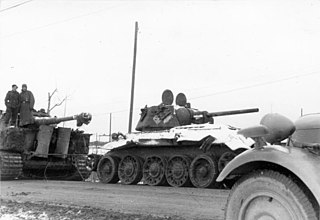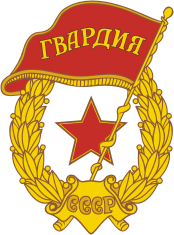
Operation Uranus was a Soviet 19–23 November 1942 strategic operation on the Eastern Front of World War II which led to the encirclement of Axis forces in the vicinity of Stalingrad: the German Sixth Army, the Third and Fourth Romanian armies, and portions of the German Fourth Panzer Army. The Red Army carried out the operation at roughly the midpoint of the five-month long Battle of Stalingrad, aiming to destroy German forces in and around Stalingrad. Planning for Operation Uranus had commenced in September 1942, and developed simultaneously with plans to envelop and destroy German Army Group Center and German forces in the Caucasus.

The Third Battle of Kharkov was a series of battles on the Eastern Front of World War II, undertaken by Nazi Germany's Army Group South against the Soviet Red Army, around the city of Kharkov between 19 February and 15 March 1943. Known to the German side as the Donets Campaign, and in the Soviet Union as the Donbass and Kharkov operations, the German counterstrike led to the recapture of the cities of Kharkov and Belgorod.

Operation Winter Storm, a German offensive in December 1942 during World War II, involved the German 4th Panzer Army failing to break the Soviet encirclement of the German 6th Army during the Battle of Stalingrad.
Army Group A was the name of three distinct army groups of the Heer, the ground forces of the Wehrmacht, during World War II.

Case Blue was the Wehrmacht's plan for the 1942 strategic summer offensive in southern Russia between 28 June and 24 November 1942, during World War II. The objective was to capture the oil fields of Baku, Grozny and Maikop for two purposes: to enable the Germans to re-supply their low fuel stock and also to deny their use to the Soviet Union, thereby bringing about the complete collapse of the Soviet war effort.

Operation Little Saturn was a Red Army offensive on the Eastern Front of World War II that led to battles in Don and Chir rivers region in German-occupied Soviet Union territory in 16–30 December 1942.

The Battle of Debrecen, called by the Red Army the Debrecen Offensive Operation, was a battle taking place from 6 to 29 October 1944 on the Eastern Front in Hungary during World War II.

The 4th Panzer Army, operating as Panzer Group 4 from its formation on 15 February 1941 to 1 January 1942, was a German panzer formation during World War II. As a key armoured component of the Wehrmacht, the army took part in the crucial battles of the German-Soviet war of 1941–45, including Operation Barbarossa, the Battle of Moscow, the Battle of Stalingrad, the Battle of Kursk, and the 1943 Battle of Kiev.

The 3rd Army was a field army of the Romanian Land Forces active from the 19th century to the 1990s. It fought as part of the German Army Group B during World War II, in Ukraine, the Crimea, and the Caucasus. General Petre Dumitrescu commanded the 3rd Army for much of that time.

The 17th Panzer Division was a formation of the Wehrmacht in World War II. It was formed in November 1940 from the 27th Infantry Division. It took part in Operation Barbarossa, the invasion of the Soviet Union in June 1941, and in the winter of 1941–42 participated in the Battle of Moscow. In November 1942, the division was sent to the southern sector of the Eastern Front where it participated in Operation Winter Storm, the failed attempt to relieve the surrounded troops at Stalingrad. The division was held in reserve during the Battle of Kursk in 1943, and thereafter retreated through Ukraine and Poland, before ending the war in Czechoslovakia.

Two Romanian armies, the Third and the Fourth, were involved in the Battle of Stalingrad, helping to protect the northern and southern flanks respectively, of the German 6th Army as it tried to conquer the city of Stalingrad defended by the Red Army in mid to late 1942. Underpowered and poorly equipped, these forces were unable to stop the Soviet November offensive, which punched through both flanks and left the German 6th Army encircled in Stalingrad. The Romanians suffered enormous losses, which effectively ended their offensive capability on the Eastern Front for the remainder of the war.
The Soviet 21st Army was a field army of the Red Army during World War II.

The Belgorod–Kharkov strategic offensive operation, or simply Belgorod–Kharkov offensive operation, was a Soviet strategic summer offensive that aimed to recapture Belgorod and Kharkov, and destroy Nazi German forces of the 4th Panzer Army and Army Detachment Kempf. The operation was codenamed Operation General Rumyantsev, after the 18th-century Field Marshal Peter Rumyantsev and was conducted by the Voronezh and Steppe Fronts in the southern sector of the Kursk Bulge. The battle was referred to as the Fourth Battle of Kharkov by the Germans.
Operation Hannover or Operation Hanover was a German operation in April–June 1942 aimed at eliminating Soviet partisans, airborne troops and encircling Red Army soldiers near Vyazma. The operation was a complete success for the Germans.

The Battle of Bologna was fought in Bologna, Italy from 9–21 April 1945 during the Second World War, as part of the Spring 1945 offensive in Italy. The Allied forces were victorious, with the Polish II Corps and supporting Allied units capturing the city on 21 April.

The 4th Guards Rifle Division was reformed as an elite infantry division on September 18, 1941, from the 1st formation of the 161st Rifle Division as one of the original Guards formations of the Red Army, in recognition of that division's participation in the successful counter-offensive that drove German forces out of their positions at Yelnya. The division then moved northwards to serve in the defense of Leningrad, as well as the early attempts to break that city's siege, but later was redeployed to the southern sector of the front as the crisis around Stalingrad developed. The 4th Guards took part in Operation Uranus which surrounded the German 6th Army in and around that city and then in the pursuit operations that drove the remaining German forces from the Caucasus steppes and the city of Rostov. The division remained in this sector for the duration of the war, fighting through the south of Ukraine through the summer of 1943 and winning the Order of the Red Banner in the process; it was further distinguished with the award of a battle honor in February, 1944. During April and May its advance was halted during the battles along the Dniestr River, but resumed in the August offensive that carried it and its 31st Guards Rifle Corps into the Balkans. It served extensively in the fighting through Hungary and in the outer encirclement during the siege of Budapest in the winter of 1944/45 and in mid-April was awarded a second battle honor for its part in the capture of Vienna. Despite this distinguished service the division was disbanded in 1946.
The 81st Cavalry Division was a mounted division of the Red Army that served in the first years of the Great Patriotic War. It was formed in the autumn of 1941 and served in the region south of Stalingrad while the German Army besieged that city in the autumn of 1942. During the first stages of the Soviet counteroffensive, Operation Uranus, the 81st was given a prominent role in the exploitation to the southwest, but became overextended and vulnerable to the mobile German reinforcements arriving to attempt a breakthrough to their 6th Army. The division was badly mauled in the opening stages of Operation Winter Storm, but continued to serve in Southern Front's advance on Rostov and on into the Donbass. It was finally disbanded in May, 1943.
LVII Panzer Corps was a panzer corps in the German Army during World War II.
The 41st Guards Rifle Division was formed as an elite infantry division of the Red Army in August 1942, based on the 1st formation of the 10th Airborne Corps, and served in that role until after the end of the Great Patriotic War. It was the last of a series of ten Guards rifle divisions formed from airborne corps during the spring and summer of 1942. It was briefly assigned to the 1st Guards Army in Stalingrad Front, then to the 24th Army in Don Front, and suffered heavy casualties north of Stalingrad before being withdrawn to the Reserve of the Supreme High Command for a substantial rebuilding. Returning to 1st Guards Army in Southwestern Front in November it took part in Operation Little Saturn as part of 4th Guards Rifle Corps and then advanced into the Donbas where it was caught up in the German counteroffensive in the spring of 1943. During the summer and fall the division fought its way through eastern Ukraine as part of the 6th, and later the 57th Army under several corps commands. It would remain in the southern part of the front for the duration of the war. By February 1944 it was in the 7th Guards Army and took part in the battle for the Korsun Pocket, winning its first battle honor in the process. Shortly after it was transferred to the 4th Guards Army, where it would remain for the duration, still moving through several corps headquarters. The 41st Guards saw limited service in the first Jassy-Kishinev offensive in the spring, but considerably more in August's second offensive and several of its subunits received battle honors or decorations. The division itself won a second honorific during the offensive into Hungary in January 1945 and was later decorated for its role in the capture of Budapest. After the fall of Vienna in April it did garrison duty in the city for a short time before being directed west into lower Austria where it linked up with U.S. forces in the last days of the war. In October, while still in Austria, it was converted to the 18th Guards Mechanized Division.












